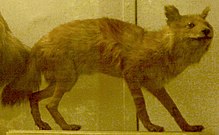Sumatran dhole
| Sumatran dhole | |
|---|---|

| |
| Exhibit of Sumatran dhole | |
| Scientific classification | |
| Domain: | Eukaryota |
| Kingdom: | Animalia |
| Phylum: | Chordata |
| Class: | Mammalia |
| Order: | Carnivora |
| Family: | Canidae |
| Genus: | Cuon |
| Species: | |
| Subspecies: | C. a. sumatrensis
|
| Trinomial name | |
| Cuon alpinus sumatrensis (Hardwicke, 1821)
| |
| Synonyms | |
|
Cuon alpinus javanicus | |
The Sumatran dhole (Cuon alpinus sumatrensis), also known as the Sumatran wild dog[2] is a subspecies of dhole[3] native to the Indonesian islands of Sumatra.[4]
Evolutionary history

As of 2005, the origin of the Sumatran dhole is unclear, as it shows a greater relatedness to the Ussuri dhole rather than with dholes in nearby Malaysia. In the absence of further data, it is speculated that the dholes of Indonesia could have been introduced to the Sunda Islands by humans.[5]
Physical description
The Sumatran dhole is the smallest dhole subspecies. It has bright red fur. The Sumatran dhole lacks woolly underfur. Instead, it has a darker coarse and leaner fur, similar to the southernmost populations of Ussuri dholes in India and Indochina; however, it has more black on the back.[6]
Range and habitat
The Sumatran dhole range is highly fragmented and Indonesian dholes are confirmed to live in multiple protected areas of Sumatra and Java.[1] In 2014, camera trap videos in the tropical forests of the Kerinci Seblat National Park in Sumatra revealed the continued presence of dholes in the area.[7] Dholes are completely extinct in Singapore. Sumatran dholes live in scrublands, grasslands, plains, tropical forests and rainforests.[1]
Threats
Habitat loss and fragmentation is a major threat to Sumatran dholes living in protected areas in Indonesia, particularly those on Sumatra. Habitat loss is driven by several different factors, including logging, palm and rubber plantations, agriculture expansion, rural biomass extraction, livestock grazing and major infrastructure expansion.[1]
References
- ^ a b c d Kamler, J.F., Songsasen, N., Jenks, K., Srivathsa, A., Sheng, L. & Kunkel, K. (2015). "Cuon alpinus". IUCN Red List of Threatened Species. 2015: e.T5953A72477893. doi:10.2305/IUCN.UK.2015-4.RLTS.T5953A72477893.en.
{{cite journal}}: CS1 maint: multiple names: authors list (link) - ^ Charles Knight & Company (1845). The History of the Dog: Its Origin, Physical and Moral Characteristics, and Its Principal Varieties.
- ^ Wozencraft, C. W. (2005). "Order Carnivora". In Wilson, D. E.; Reader, D. M. (eds.). Mammal Species of the World: A Taxonomic and Geographic Reference. Vol. 1 (3rd ed.). Johns Hopkins University Press. p. 578. ISBN 978-0-8018-8221-0.
- ^ Lydekker, R. (1907). The game animals of India, Burma, Malaya, and Tibet. London: R. Ward Limited.
- ^ Iyengar, A.; Babu, V. N.; Hedges, S.; Venkataraman, A. B.; Maclean, N.; P. A. Morin (2005). "Phylogeography, genetic structure, and diversity in the dhole (Cuon alpinus)" (PDF). Molecular Ecology. 14 (#8): 2281–2297. doi:10.1111/j.1365-294X.2005.02582.x. PMID 15969714.
{{cite journal}}: Unknown parameter|last-author-amp=ignored (|name-list-style=suggested) (help) - ^ Mivart, G. (1890), Dogs, Jackals, Wolves and Foxes: A Monograph of the Canidæ, London : R.H. Porter : Dulau, pp. 177–88
- ^ "Sumatran secrets start to be revealed by high altitude camera trapping - Fauna & Flora International". www.fauna-flora.org.

